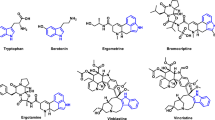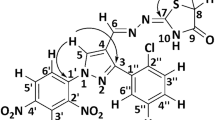Abstract
The reaction of two equivalents of sodium azide with diarylaminodibromo-p-benzoquinone (I) in DMF for 15–24 h produced quinoxalinophenazinediones together with a byproduct identified as diarylaminodiaminobenzoquinone. On the other hand, the reaction of bromanil with active methylenes, such as diethyl malonate and ethyl acetoacetate, resulted in disubstitution products which, on treatment with primary amines, cyclized into benzodipyrroletetrones. Comparative antifungal and antibacterial studies were made.
Similar content being viewed by others
References
Boggust, W. A., Cocker, W., Schwarz, J. C. P., & Stuart, E. R. (1950). Some naphthothiazoles. Journal of the Chemical Society, 1950, 680–682. DOI: 10.1039/JR9500000680.
Boyle, V. J., Fancher, M. E., & Ross, R. W., Jr. (1973). Rapid, modified Kirby-Bauer susceptibility test with single, high-concentration antimicrobial disks. Antimicrobial Agents and Chemotherapy, 3, 418–424.
Dudley, K. H., & Miller, H. W. (1970). Potential naphthoquinone antimalarials. 2-Acylhydrazino-1,4-naphthoquinonones. Journal of Medicinal Chemistry, 13, 535–537. DOI: 10.1021/jm00297a044.
Foltinova, P., Sutoris, V., Blockinger, G., & Ebringer, L. (1978). Antimicrobial effects of some benzothiazol derivatives. Folia Microbiologica, 23, 225–228.
Hammam, A. S., Youssef, M. S. K., Atta, F. M., & Mohamed, T. A. (2007). Synthesis of new triphenodithiazine-and indolocarbazolediones of biological interest. Chemical Papers, 61, 292–299. DOI: 10.2478/s11696-007-0036-1.
Hammam, A. S., Youssef, M. S. K., Radwan, S. M., & Abdel Rahman, M. A. (2004). Synthesis of a new Diels-Alder quinone adduct and its use in preparing thiazolo-and oxazoloquinolines. Bulletin of the Korean Chemical Society, 25, 779–785.
Kersten, W. (1971). Inhibition of RNA synthesis by quinone antibiotics. Progress in Molecular and Subcellular Biology, 2, 48–57.
Kitasato, Z., & Sone, C. (1930). Synthese des N-methyloxynaphtindolchinons und N-methylnaphthoisatinchinons. Bulletin of the Chemical Society of Japan, 5, 348–354.
Kwon-Chung, K. J., & Bennett, J. E. (1992). Medical mycology. London: Lea & Febiger.
Liebermann, C. (1899). Ueber Farbreaktionen von Indonen und Chinonen mit Malonsäurederivaten. Berichte der deutschen chemischen Gesellschaft, 32, 260–267. DOI: 10.1002/cber.18990320141.
Liebermann, C. (1900). Ueber die malonesterartigen Derivate des Dibrom-α-naphtochinons. (IV. Mitteilung). Berichte der deutschen chemischen Gesellschaft, 33, 566–578. DOI: 10.1002/cber.19000330193.
Ling, A. J., Padini, R. S., Cosby, L. A., Lillis, B. J., Shansky, C. W., & Sartorelli, A. C. (1973). Potential bioreductive alky-lating agents. 2. Antitumor effect and biochemical studies of naphthoquinone derivatives. Journal of Medicinal Chemistry, 16, 1268–1271. DOI: 10.1021/jm00269a010.
Martin, Y. C., Bustard, T. M., & Lynn, K. R. (1973). Relation between physical properties and antimalarial activities of 1,4-naphthoquinones. Journal of Medicinal Chemistry, 16, 1089–1093. DOI: 10.1021/jm00268a005.
Meganathan, R. (2001). Biosynthesis of menaquinone (vitamin K2) and ubiquinone (coenzyme Q): A perspective on enzymatic mechanisms. Vitamins and Hormones — Advances in Research and Applications, 61, 173–218.
Morton, R. A. (Ed.) (1965). Biochemistry of quinones. New York: Academic Press.
Nohl, H., Jordan, W., & Youngman, R. J. (1986). Quinones in biology: Functions in electron transfer and oxygen activation. Advances in Free Radical Biology & Medicine, 2, 211–279. DOI: 10.1016/S8755-9668(86)80030-8.
Olenick, C. G., & Hahn, F. E. (1974). Bactericidal action of a 2-hydroxy-3-alkyl-1,4-naphthoquinone. Annals of the New York Academy of Sciences, 235, 542–552.
Pardee, A. B, Li, Y. Z., & Li, C. J. (2002). Cancer therapy with β-lapachone. Current Cancer Drug Targets, 2, 227–242.
Rich, S. (1969) In T. G. Torgeson (Ed.), Fungicides. An advanced treatise. New York: Academic Press.
Van Allan, J. A., Reynolds, G. A., & Adel, R. E. (1963). Polynuclear heterocycles. III. The chlorination and nitration of benzo[b]phenazine. Journal of Organic Chemistry, 28, 520–524. DOI: 10.1021/jo01037a065.
Van Cutsem, J., Kurata, H., Matsuoka, H., Mikami, Y., Pfaller, M. A., Scalarone, G. M., & Rinaldi, M. G. (1994). Antifungal drug susceptibility testing. Journal of Medical and Veterinary Mycology, 32, 267–276.
Author information
Authors and Affiliations
Corresponding author
Rights and permissions
About this article
Cite this article
Hammam, A.S., Youssef, M.S.K., Atta, F.M. et al. Synthesis of new quinoxalinophenazinediones and tetrahydrobenzodipyrrolotetrones of biological interest. Chem. Pap. 62, 194–206 (2008). https://doi.org/10.2478/s11696-008-0011-5
Received:
Revised:
Accepted:
Published:
Issue Date:
DOI: https://doi.org/10.2478/s11696-008-0011-5




